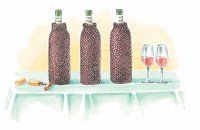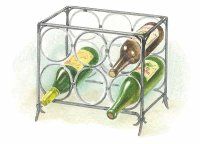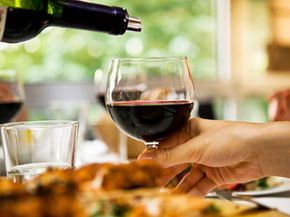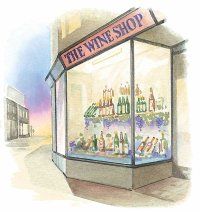Nothing contributes more significantly to your wine experience than tasting. It's kind of like learning to play an instrument; it's helpful to know how to read music, but ultimately, there's no substitute for practice.
Coming together with a group of fellow wine enthusiasts is a fantastic way to exercise your tasting muscles. A group atmosphere offers participants the opportunity to share opinions and conclusions, shaping and strengthening each individual's appreciation of the wine. The concept is similar to that of a book club. Sure, you can enjoy a novel on your own. But getting together with a group of people who have read the same book can enhance your appreciation and understanding of the story.
Advertisement
The following article shows you the key steps in hosting a wine tasting -- from the planning stage to choosing a theme -- so that it will be a truly meaningful experience. We'll start by addressing a few basics you should consider when planning a wine tasting.
Blind Tasting

Organizing a wine tasting is easy; all you'll need are good friends and (hopefully) good wine. Whether you decide to plan an occasion that's formal and serious or casual and low-key, a blind tasting (where the tasters don't know which wine is in which glass) is your best bet. Concealing the wine's identity is vital if purely sensory evaluations are to be made. Otherwise, the power of suggestion can cloud a taster's ability to honestly evaluate a wine; impressions are likely to be influenced, whether consciously or unconsciously, by expectation rather than by what the senses actually encounter.
The More the Merrier?
So, how many people should you include in your tasting group? In general, the more the merrier! More tasters means more opinions, increasing the base for interaction. And if you plan to pool your resources to finance the wine purchases, more people can mean a wider range and/or better-class of wines. Still, keep in mind that a bottle of wine can only go so far. A regular (750 ml) bottle contains about 25 ounces. If a tasting sample is two ounces, one bottle can accommodate up to 12 people. But, if the group exceeds 12 participants, it will be necessary to either buy more than one bottle of each wine to be sampled or pour smaller tasting samples from a single bottle.
Details, Details
Before the first tasting, get your friends together for a planning session. Now is the time to work out the details so the event itself can be a festive, carefree occasion.
Choose a date and time for the get-together. Who will host the tasting? Will the host be responsible for setup and cleanup? For purchasing the wines? Decide in advance which group member will be responsible for each element of the event. After all, it's impossible to have a tasting without the wine! Pick a site for the tasting. Make certain the location has sufficient table space and chairs to accommodate the tasters and their glasses. The most comfortable and hassle-free site is probably a cozy dining room. If this isn't possible, then you'll have to be creative. Does a group member have access to a semipublic room, such as a recreation room at a condominium or an apartment complex? If so, consider booking the room for the tasting. Other possibilities include a meeting room in an office suite or a separate room in a restaurant (the owner might be persuaded to make the room available if your group dines at the restaurant following the tasting).
Determine how many wines will be sampled. Agree on a minimum number, so the host will know how many wines to obtain. Also decide whether the tasters are to bring their own glasses. If so, consider tasting six wines; boxed stemware often comes in sets of six, and the compartmental boxes make carrying the glasses to and from the tasting much more convenient.

Decide how the wines will be paid for. Some wines might be significantly higher in price, and some tasters may drop out along the way, so it's important to resolve this issue early on. Consider simply dividing the total cost by the number of people participating. Don't forget to factor in any amount spent for bread or cheese! Or, take turns hosting (and paying for) the event. Perhaps you can make it a monthly get-together!
Create or obtain a tasting sheet. Many wineries have tasting sheets that can be adapted for the group's purposes, or you can create your own. Whatever you choose to do, make sure to duplicate the form so that you have a copy for each taster.
The tasting sheet should include the number or letter that corresponds to each wine; space for comments; points awarded, if desired (the common systems are the 20-point and 100-point scales); an individual ranking, from first place to last place; and total group ranking points. To calculate total group ranking points, find out what ranking each taster gave each wine. If six people believe the same wine deserves to be in first place, it gets six group points (631=6); if they all put the wine in sixth place, it gets 36 points (636=36). The lower the total ranking score, the higher the group ranking for the particular wine.
Choose a tabulator and create a tabulator's sheet. Decide which group member will act as the tabulator. This can change from tasting to tasting, or the same person can do it each time. The tabulator compiles each taster's rankings as well as each taster's point awards, if points are used (keep in mind that rankings are much more important than point values; awarding points is a very subjective exercise and can lead to considerable confusion). Design a sheet that enables the tabulator to readily calculate these figures. You might also want to develop simple slips of paper for group members to use to transmit their rankings (and scores, if used) to the tabulator.
For tips on how to choose a theme for your wine-tasting party, read the next section.
Advertisement

